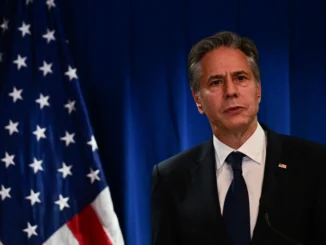
If you have not heard about the rise of geopolitics over the past year, where have you been hiding?
So now I want to complicate your lives further and introduce you to its lesser-known but arguably even more important cousin: geoeconomics. Another fancy name for a nebulous concept that boffins regularly confuse you with, you say? Perhaps. But hear me out.
First, let’s begin with a (clunky) definition from my go-to think tank of the moment, Chatham House: “The term ‘geoeconomics’ has become popular but lacks an agreed definition. Most commonly, it is understood as the use of economic tools to advance geopolitical objectives. Other definitions reverse the ends and means, emphasising how flexing geopolitical muscle is used for economic results. Broadly, one can think of the interplay of international economics, geopolitics and strategy.”
I buy this definition, but, in this essay, I want to de-emphasise, where I can, the politics: in today’s fractious world, geopolitics has a way of hijacking almost any discussion to the extent that other considerations barely merit a look-in. I will rather emphasise the geoeconomic data and make a few suggestions as to how this data might be interpreted geopolitically.
Those who know me will know my bedrock contention is that the centre of economic gravity is moving resolutely back to Asia from whence it came some 200 years ago. There is deep demographic logic to this return migration: over half the world’s population lives within 3,200km of Mong Khet in north-eastern Myanmar, inside what is known as the Valeriepieris Circle.
I came across a new statistic last week that reinforces this paradigm shift: 113 million people will enter the world’s consuming classes next year, with 83% or 94 million being Asian, and only 4% or five million from the West.
And, for the first time, India will beat China 33 million to 31 million, underlining the fact that in 2023, India’s population rise overtook China’s.
This population centre of gravity is centrifugally pulling in the geoeconomics: McKinsey estimates the geographic centre of economic gravity in 2023 to be near Kyzyl, on the Russian side of its border with Kazakhstan.
As recently as 1990, this core was close to Norway’s Svalbard Islands; by 2030, it is forecast to be in northern China. From the icy Greenland Sea to the arid Gobi Desert in 40 years? That is paradigm-shifting.
But this is not the narrative you will hear on Bloomberg or CNBC. This is because they inhabit the atmosphere of capital – of “financial markets” – rather than that of trade. The capital atmosphere is captured in movements in stock markets and bond markets and, at a macroeconomic level on a nation’s capital account; furthermore, the only “language” it speaks fluently is nominal US dollars.
By contrast, the atmosphere of trade is best reflected in trade statistics as recorded on a nation’s current account and is very (and I mean very!) approximately measured in Purchasing Power Parity “dollars”. By the latter measure, China overtook the US as the world’s largest economy in 2014 and is now 22% larger. By the former measure, the US economy is still 32% larger than China’s.
Unsurprisingly, the narrative of capital markets remains focused on what is happening in US stock and bond markets: over 60% of the All Country World Index for equities is in US securities, as is over 40% of the All Bond Index.
Add to this the fact that the go-to US dollar index for FX markets is the DXY, an index composed of six Western currencies: the euro, yen, pound, Canadian dollar, Swedish kronor and Swiss franc. Even though Mexico and China are the US’ second and third-largest trade partners, there are no “trade-rich” pesos or renminbi in this “capital atmosphere” basket.
The atmosphere of trade reflects altogether different realities and is perhaps best captured in the statistic that, in 2022, China’s $3.6-trillion worth of exports beat the US’ $2.2-trillion. Without the US’ oil and gas sales abroad, China’s export total would be almost twice that of the US.
It will take several years for the Western-focused world of capital to align with the increasingly Asian-centred world of trade. And much of this catch-up will be facilitated not just by GDP growth in China, but also in ABC: Asia Beyond China.
The latest economic forecasts coming from the IMF’s September annual meeting in Marrakesh clearly show that Asia (and again, not just China) has become the world’s GDP growth locomotive: 2024’s 94 million out of 113 million new members of the world’s consuming classes being Asian will bear witness to that.
If you look through the prism of capital, you can make a case for the argument that the US-centric world is indeed deglobalising. But if you instead peer through the prism of trade, what you see is a world that is re-orienting (pun intended) – one that is moving into the heart of Asia by leaving the North Atlantic behind.
In the meantime, one can broadly expect the pre-eminent status of the US dollar – in its money functions as a store of value, a unit of account and as a standard of deferred payment – to hold sway. (That said, the US dollar’s share of global FX reserves has fallen 6% to under 60% in the past decade.)
What is changing most is that the world is witnessing the US dollar’s grip on the medium of exchange function slip, especially in commodity markets, be it UAE gas exports to India denominated in dirhams, or Indonesian nickel and Australian iron ore exports to China denominated in renminbi.
As the world moves from the post-Cold War unipolarity of the US to the age of multipolarity where many nations participate in helping define the economic character of the global economy, one refrain is constantly heard from these new players: “As a nation, we act in our own best interests: we do what works for us.”
So India will not join a US-led oil embargo on Russia which prevents them from settling that trade in US dollars. Instead, India is perfectly willing to pay Russia for its oil, even if it does so in Chinese renminbi.
And much to the chagrin of the US – which saw the dollar-based New York Clearing House mechanism as an irreplaceable link in the chain of most global trade – countries are finding that bypassing the dollar is surprisingly easy to do. And, what’s more, it is often cheaper too.
All of this threatens the economic hegemony of the US, and not just in the international arena as described above. Before long, these tectonic shifts are likely to have profound – and profoundly destabilising – implications for the US domestic economy as well.
But back to those two atmospheres – one for capital, one for trade. They intersect in a nation’s current account position. For the US, their current account deficit means they are short the trade atmosphere by about $1-trillion a year and so – if the dollar is to hold its value, the US must be long of roughly an equivalent amount of imported capital from the rest of the world’s capital atmosphere.
Those nations that run current account surpluses – the Eurozone, China, Japan, Switzerland and Saudi Arabia, for example – are long the trade atmosphere and so are net contributors of their surpluses to that capital atmosphere. (Economists also characterise this situation as a nation that runs a current account deficit as being savings deficient and therefore needing to import savings through their capital account, savings generated from the current account surpluses run by other countries.)
So far, so good. But this is where the geoeconomics moves to another much higher level… and yes, this is where geopolitics starts to enter the equation.
Such is the level of net dissavings by the US created by its current account deficit that it generates 60% plus of ALL such deficits worldwide. In other words, the US consumes 60% plus of all internationally mobile savings to balance its trade-short external account. Sixty percent? Not bad for 4.2% of the world’s population!
And there are growing signs that at least some of those nations previously providing their savings to the US are growing weary of funding what is in effect the US’ excess consumption. Another way of saying this – using the logic of Ben Bernanke, the former chairman of the US Federal Reserve, but applying it in reverse – is that some of the world’s “surplus savers” no longer feel so inclined to let the US’ “surplus consumption” absorb the lion’s share of those savings.
Before proceeding, it is worth detailing exactly to what ends these surplus savings have been applied. The TICS data provided monthly by the US Treasury tells us where these savings go. (All figures are net flows; all trends are those evident over the past decade.)
Since 2014, foreign flows into US equities have – albeit with fluctuations, especially over Covid – been on a generally declining trend. Similarly, flows from foreign official sources like central banks have declined to be almost negligible today.
So what has been the principal destination for private foreign capital inflows – part of those foreign excess savings – into the US? The short answer is not US Inc equity instruments, but rather US government debt instruments. In particular, foreigners have bought Treasury Bonds and Bills, with much smaller amounts going into still-government-backed Agency Bonds as well as corporate bonds.
For the year to end September 2023, these net flows have been Treasuries $597-billion, Agency Bonds $125-billion; and Corporate Bonds $187-billion, together a total inflow of $909-billion.
Add in net flows into equities for the same period – $168-billion – and the US current account deficit is essentially covered, allowing the imbalance of its trade atmosphere to be “equilibrated” by that “kindness of strangers”: capital, or more precisely, savings from abroad.
As the above category totals show, foreign savings flowing into US Treasuries ($597-billion) contribute to the funding of the US’ budget deficit, this year forecast to top $1.7-trillion.
As a past rule of thumb, I estimated this kindness of strangers would fund over half of the US’ annual budget deficit, but this 50%+ ratio may now also be falling.
Earlier this year, the 12-month total into US Treasuries was close to $1-trillion; the subsequent drop off to $597-billion by September may help explain the disastrous performance of the US Treasury market in 2023.
Are foreigners “falling out of love” with US Treasuries? Given the disastrous performance of US Bonds since 2021, it would not be a surprise.
Now add this final observation to the mix: that the US, again with only 4.2% of the world’s population, runs over 42% of all budget deficits worldwide.
With these factual foundations laid down, let us now move on to the emerging geoeconomic tensions in the global economy; tensions that are exacerbated by the intensifying winds of geopolitics, be they blowing from Ukraine, Gaza or Taiwan.
There is growing evidence that leading players in the non-West – sometimes collectively called the Global South – are increasingly impatient with the underhand way the West loads the dice in its favour in the playing of the world economic game.
On 14 December 2022, the UN General Assembly voted on a resolution: “Towards a New International Economic Order”. The vote split perfectly between the Rest (123 in favour) and the West (50 against): only Türkiye abstained.
West vs Rest unanimity in this vote was near total, and there were plenty of democracies who voted in the latter camp: it was not a divide between democracies and autocracies.
However, there is far from unanimity in the reasons for this impatience among the Rest, and even less agreement as to what sort of economic order might replace it. But there is a coalescing sense coming from these discontents around the idea of, “well, definitely not the current one!”
So far, I have not seen any analysis where this impatience takes the form of: “Since some of we non-Westerners provide a sizeable share of our surplus savings to keep the US show on the road (and, albeit on a smaller scale, the British one), unless things really start to change, we might see fit to withhold some or all of those savings.”
But I fully expect a researcher in, say, the BRICS New Development Bank to put two and two together and come up with four.
Often, it seems as if a political event might give further impetus to the campaign to reform underlying economic grievances.
When the United States vetoed a resolution from BRICS founding member Brazil at the UN Security Council calling for “humanitarian pauses” in the Gaza conflict, it again highlighted the powerlessness of current multilateral institutions to address those issues that concern the wider UN Assembly: economic advancement and security and human rights for all – not just for those communities favoured by the West.
This resolution came soon after the end of the annual International Monetary Fund and World Bank meeting in Morocco. At Marrakesh, the contentious issue of global governance reform was again raised.
The IMF is arguably the most important economic organisation that the Global South wants reformed. At present, it has skewed-to-the-West voting ratios: the US’ 17.4% is almost three times that of China; the UK’s significantly larger than India, and Belgium’s is bigger than Indonesia.
The reforms envisaged would upend the pro-Western voting weights, including possibly ending the US’ right of veto were its quota to fall below 15%.
Likewise, the “droit de seigneur” exercised by the US and Europe at the two Washington DC multi-laterals (where the US gets to choose the head of the World Bank while Europe gets to nominate the head of the IMF) may need to be replaced with a more “democratic” arrangement.
Meanwhile, over at the UN, it is becoming increasingly untenable for the permanent five members of the Security Council (and especially the US, UK and France) to stall Indian and even Brazilian membership of that inner grouping.
Finally, this time thinking geostrategically, what might happen to the US’ defence budget ($837-billion) if foreign inflows began to dry up? That budget currently allows the US to spend more on defence than the next 10 countries combined and, in so doing, maintain over 750 foreign bases – 80% of all foreign bases worldwide.
My primary interest however is focused on the geoeconomic fallout of a possible shift away from non-Western countries choosing to deploy their international savings in US government debt instruments and thereby underwrite the ballooning US government deficit.
The reason for this is that their actions may yet destabilise the foundation of US capital markets: the US bond market. This they would do by undermining the foundational price of risk in global capital markets, the yield on the 10-year US Treasury.
It is difficult to speculate as to what would be the full ramifications if these non-Western surplus recyclers were to shift even some of their surplus savings elsewhere. Yet, as it is, there is tentative evidence that they are beginning to do just that.
And, though the connection is all but impossible to “prove”, this could be one reason why Western financial markets – led by that axiomatic US bond market – have been struggling for nearly three years. (This period has led to the worst returns for US bonds since 1871.)
Already we see that several surplus-running countries outside the West seem less inclined to recycle the same share of their surpluses into US securities as previously: even the Saudis have reduced their central bank Treasury Bill holdings by 45% in the past three years, to $108-billion today.
Instead, these surplus runners have directed more of their national savings towards a variety of alternative assets. Gold reserves have risen sharply in the Global South central bank community, notably in China, Russia, India, the Central Asian “stans” and Türkiye: in the first nine months of 2023, such holdings rose 800 tonnes, over seven times South Africa’s 2022 production of 110 tonnes.
Sovereign wealth funds from Greater Arabia are increasing their exposure to Asian assets, including private equity and property. Middle Eastern companies – especially in the oil and petrochemical sectors – have been increasing their foreign direct investments in existing companies as well as start-ups across Asia, including China and India.
Perhaps the most telling strategy of all comes from the biggest surplus runner: China. While systematically reducing its US Treasury holdings – from $1.3-trillion in 2014 to under $800-billion today – it appears as if a sizeable share of China’s surplus has rather been recycled into its strategic stockpiles of commodities.
Besides gold, oil, nickel, uranium and cobalt have all seen notably large Chinese purchases beyond China’s current consumption needs. Perhaps the most unremarked upon “beneficiary” has been grains. China now holds 70% of world maize reserves, 60% of rice, 50% of wheat and 30% of soya. (Note under IMF rules, gold can be included in their definition of FX reserves, but other commodities cannot.)
So how do these geoeconomic facts connect to the geopolitical environment? My sense is that the two are connected by a two-way feedback mechanism, where the geopolitical concerns get reflected onto the geoeconomic foundation and vice versa. Increasingly, political and economic decisions are then taken by nations – individually, collectively – that align both. All this tends to happen while prioritising an individual nation’s economic self-interest in the process.
If this is so, given that the US and much of the West are floundering in the geopolitical arena, the world is seeing nations outside the West taking actions that could destabilise the current economic structure of the world – and particularly in the atmosphere for capital – as we have come to know it.
Evidence of this growing frustration in the Rest with the priorities of the West was well captured in a quote from the Indian Foreign Minister, Subrahmanyam Jaishankar: “Somewhere, Europe has to grow out of the mindset that Europe’s problems are the world’s problems, but the world’s problems are not Europe’s problems.”
Many countries in the Rest would add the US to Europe in this quote.
Add to this the growing perception in much of the Rest that the moral high ground the Western democracies occupied for much of the postwar era is increasingly tarnished. The US-led wars in Iraq and Afghanistan – where, respectively, no weapons of mass destruction and no Osama bin Laden were found – accelerated this process; neither invasion was sanctioned by the UN, but both went ahead regardless.
The Gaza conflict provides an all-too-tragic current example. Many non-Western nations (though not South Africa) supported the West’s position on Ukraine in the UN, some decrying the neo-imperialism exhibited by Russia as well as its callous approach towards the wellbeing of Ukraine’s civilians.
With that in mind, these same nations of the Rest – while unreservedly deploring Hamas’ actions on 7 October – cannot understand why so many Western nations now implicitly defend Israel’s livelihood-threatening and even life-taking actions towards Gaza’s civilians.
Some Western nations – notably the trade deficit running US – even go so far as to veto “humanitarian pauses” that would allow medicine, food and water to be distributed within the besieged Palestinian enclave. The visible squirming of the US’ UN ambassador as she vainly tried to square this sad circle was there for all UN members to see.
The charge of hypocrisy against the US and its close Western allies now hangs heavily in the air.
Such duplicitous behaviour by some Western nations means the growing reservations of the Rest leak from the geopolitical arena into the geoeconomic one. And then, by the Rest’s subsequent economic actions no longer aligning themselves to Western priorities, they leak back from the geoeconomic into the geopolitical.
And thus we find a world that is very different from that of the 1950s. For then, the winners of World War 2 mostly had right on their side: even the Europeans had begun the process of decolonisation.
Today, for all the high-minded expressions from the leaders of the West as to, “what is the right thing to do”, their mask has slipped and the old – and terrifying – logic of “might makes right” has again been revealed.
And more and more, many nations in the Rest simply do not agree with that mantra, even if, regrettably, some of those same nations still practice such behaviour too.
Thus, where they can, some of these Global South nations have resolved to take their trade – and even their surplus capital – elsewhere.
Frequently, this “elsewhere” means Asia, a destination that has the added advantage of offering product that is cheaper – and increasingly better – than that found in the West.
Indeed, the ultimate confirmation of this is that many leading Western multinationals also source their manufactured products from Asia – exhibit A, the iPhone 15 – for precisely the same two reasons.



